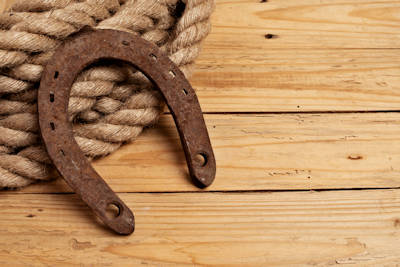Do Horses Really Need Horseshoes?
** Affiliate disclosure. This web site is supported by its awesome audience. When you click or purchase through links on our site, we may earn an affiliate commission.

When it comes to athletic performance, do horses need horseshoes? Horseshoes are beneficial for horses in a number of ways. They help the horse retain peak athletic performance, add traction, and correct soundness problems. They’re also beneficial for trail riding and other forms of horse exercise. While wearing shoes isn’t required for trail riding, the use of horseshoes is beneficial for different types of terrain. Horses in racing events, for example, are often forced to wear shoes and aluminum plates to avoid contact with dirt and debris. Racing regulations restrict the types of shoes that horses can wear on the racetrack, so it’s important for a horse to follow suit.
Equine hooves are protected by horseshoes
There are many different types of horseshoes. These shoes are designed to protect a horse’s hooves, providing increased traction and strengthening landing. Horseshoes are also important for horses that spend the majority of their time in a stable. Ammonia buildup and pricks can damage horse hooves, so it’s important to protect them whenever possible.
Another type of shoe is called a glue-on horseshoe. These are commonly used for rehabbing horses after a foot injury. Glue-on horseshoes can come in different styles, with some requiring clips on the hoof wall and others simply being glued onto the edge of the foot. As with any shoe, regular hoof maintenance is critical to maintain the shoe’s fit. Regular trimming is essential. To keep glue-on horseshoes in good condition, make sure to have them removed periodically and call an expert to trim them when necessary.
While many modern horses still have weak hooves, these ancient animals suffered from a variety of problems resulting from inadequate hoof structure. Often, horseshoes are not used properly or are even counterproductive. The idea of protecting horse hooves began with humans, and horsemen in Asia made prototypes of horseshoes. The early horseshoes were not metal shoes, but rather hoof boots that were made with dried grass in between.
While metal horseshoes are the most common type of shoe, there are also composite horseshoes made from plastic or rubber. The latter have improved shock-absorbing properties and are also suitable for horseshoeing. Composite shoes can also replace metal shoes and are made to last longer and require less regular shoeing. Several composite shoe models feature additional frog support for healthy hoof function. The clincher and the rasp are the tools needed to apply the shoe.
They provide traction
For equestrian activities, the right amount of traction is crucial for a horse’s performance and safety. Horseshoes with studs can sink into soft surfaces to give more traction and increase safety. Reining horses also wear sliding plates on their hind feet to provide traction during a sliding stop. Horses that lack traction take shorter steps and often crouch to reduce their center of gravity.
Unlike shoes with regular plates, horseshoes that are made of ice nails and Dura-Tec nails offer more traction on slippery surfaces. Borium, for example, provides better traction than steel. The latter is made of treated metal and is applied without using an oxyacetylene torch. The materials that are similar to Borium include Carbraze and Hartwell Composite Rod. If you want to try a different material, you can also experiment with a few different types to find the right one for your horse.
Generally, horseshoes are made from metal or other materials, but can be made from other materials, too. A horseshoe is usually secured to a horse’s foot with nails, but you can also temporarily install temporary protection with glue. Regardless of the type of shoe, a horseshoe has a variety of benefits, but the primary function of traction is to help horses perform better. A good pair of shoes will prevent your horse from getting injured and compromising your horse’s performance.
A traction device may be made of a non-threaded stud and an insert. The latter has inwardly protrusions and expandable wall sections. These parts form a fitting assembly that fits into a horseshoe aperture. The stud is also secured with a magnetic washer. This makes it easier to use. And if you’re wondering how traction devices work, here are a few advantages.
They reduce lameness
If you have ever wondered if horseshoes reduce lameness, you’ve probably heard the term “egg-bar shoes.” But what exactly are these? And what are their benefits? Despite their name, egg-bar shoes are not for every horse. They are generally not recommended for a swamp horse, but they are fine for most horses that experience occasional mud and other normal conditions. But if you’re considering getting them for your horse, here are some tips you should know.
One important thing to know is that a shoe may cause a horse to become lame if it does not fit properly. The problem with this is that unshod horses have deformable hooves, meaning that the bearing surface of the wall at the heel and toe is lower than the sole. As a result, the solar load distribution of the shoe is quickly changed. This causes the peripheral wall to become more abrasive, which results in increased contact with a frog or a bar.
Another important benefit of horseshoes is that they prevent foot problems, which are often the cause of lameness. Many owners overlook the foot care of their horses and let the condition go untreated. This can cause a horse to develop various conditions that can lead to severe lameness and loss of use. It is vital that your horse receive regular farrier visits so that they can properly fit the shoes for your horse.
Glue-on shoes are an excellent way to prevent a horse from becoming lame. These shoes can be made by using a Sigafoos kit. Traditional shoes must be fitted to a white line, whereas glue-on shoes are shaped according to a horse’s hoof wall. A shoe can even have a “give” so that it can conform to a horse’s foot.
They prevent ammonia from accumulating in hay
For centuries, horseshoes have been used as a way to protect a horse’s hooves from becoming infected with ammonia from urine-soaked hay. Since horses spend most of their time inside the stable, urine tends to accumulate in hay, resulting in ammonia buildup. A horseshoe prevents the ammonia from accumulating in the hay and prevents the horse from contracting a respiratory illness caused by excessive hay or urine.
Although many horses are completely barefoot, other horses will need horseshoes for various reasons. If they work on concrete or tarmac, horseshoes are a necessity. Transitioning to barefooting requires varying terrains. If your horse is hoof-strong and in good health, he may not benefit from wearing shoes. However, if you have a weak horse with weak hooves, it is better to put shoes on him than to risk the damage that shoes can cause.
Ammonia is a problem inside horse barns, especially if it is not controlled. Ammonia can be dangerous to horses because it is a irritant and can cause respiratory infections. Ammonia is produced by urine and feces, so the concentration is usually highest on the floor. In addition to hay, ammonia can also accumulate inside a horse’s barn when it is not properly ventilated.
Ammonia is a microbial byproduct of animal digestion and can get absorbed into substrates. Horse urine will soak up ammonia and cause hay to smell. It can also build up in the horse’s eyes, causing discomfort. A horseshoe will help prevent this from happening. It will also prevent the accumulation of ammonia in hay and help keep the horse’s eyes healthy.
They improve performance
Horseshoes are a necessary part of equestrian sports, as they help protect the hooves of the horse and strengthen the hoof wall. Wild horses grow hooves continuously and gradually wear them down, while domesticated working horses are typically used to pull heavy loads and carry riders. These activities add stress and additional weight, making horseshoes essential to the health and performance of the animal. They improve the durability of the hoof and help the animal perform at a high level.
Horseshoes come in a variety of materials and styles. Common materials include steel and aluminium, while specialized materials include rubber, plastic, magnesium, titanium, and copper. Steel horseshoes are favored in sports involving high-impact impact, while aluminium shoes are lighter and are preferred in dressage. Both materials provide protection, but there are some advantages to using one over the other. The shoe is important to the horse’s performance, so it’s essential to choose the right one for your horse’s type and activity.
Besides the benefits of a horse’s performance, horseshoes also improve their health and comfort. Researchers have conducted various studies to examine the effects of horseshoes on equine performance. One preliminary case study examined the effects of shoe-wear on the front feet of Thoroughbred horses. In this study, researchers used one Thoroughbred and assessed it with both unshod and shod shoes made of stainless steel.
Although the use of horseshoes is largely dependent on the purpose for which the shoes are used, horseshoes have many benefits for horses. Horseshoes can improve gaits and prevent lameness and improve the quality of life for animals with genetic deformities. Further, they can improve the condition of horses with poor feet. For those who use horseshoes on a daily basis, this may be the best choice for their equestrian needs.

Sarah is the lead content developer at HorseKids.com She also writes in the pet and wellness space. On HorseKids.com Sarah specializes in covering the top products for horse lovers and DIY tips and articles.